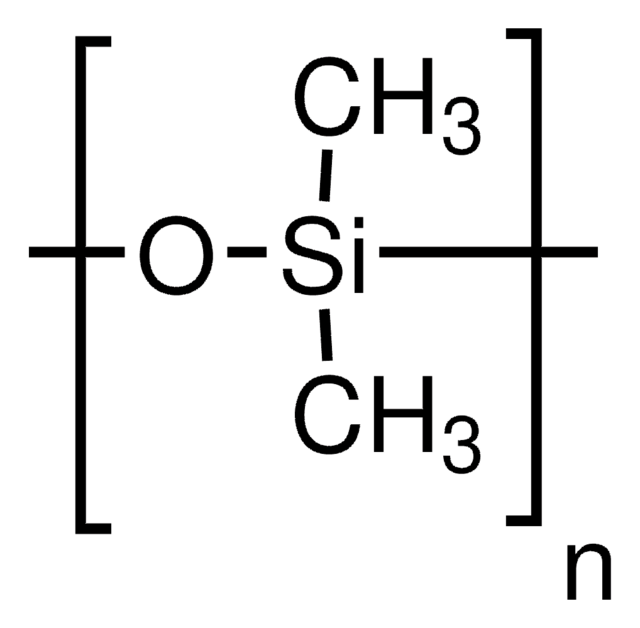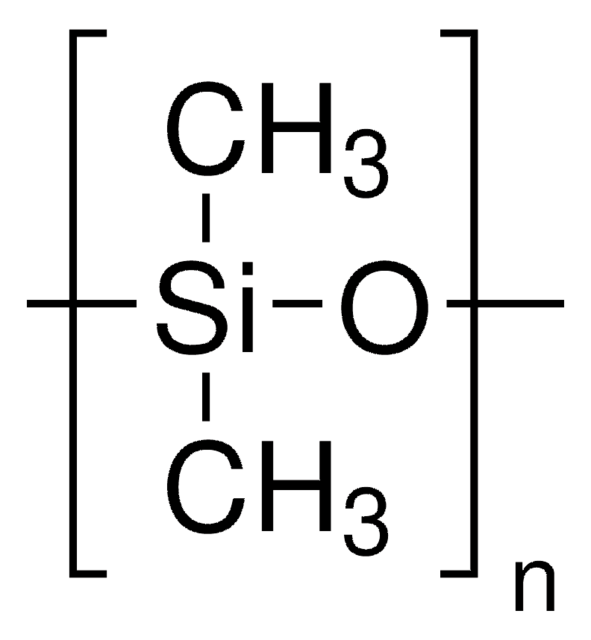DMPS1M
Dimethylpolysiloxane
viscosity 1,000 cSt (25 °C)(lit.)
Synonym(s):
Polydimethylsiloxane
Sign Into View Organizational & Contract Pricing
All Photos(1)
About This Item
CAS Number:
MDL number:
UNSPSC Code:
12352200
PubChem Substance ID:
NACRES:
NA.25
Recommended Products
form
liquid
Quality Level
mol wt
~28,000
viscosity
1,000 cSt(25 °C)(lit.)
SMILES string
CO[Si](C)(C)OC
InChI
1S/C4H12O2Si/c1-5-7(3,4)6-2/h1-4H3
InChI key
JJQZDUKDJDQPMQ-UHFFFAOYSA-N
Application
Clear, colorless fluid polymer useful as a stationary phase in gas chromatography and as an anti-foaming agent.
Dimethylpolysiloxane is used in protein chromatography and affininty chromatography. Dimethylpolysiloxane was used to determine that postprandial inflammatory response after ingestion of heated oils in obese persons is reduced by the presence of phenol compounds.
Storage Class Code
10 - Combustible liquids
WGK
WGK 1
Flash Point(F)
600.8 °F - closed cup
Flash Point(C)
316.00 °C - closed cup
Personal Protective Equipment
dust mask type N95 (US), Eyeshields, Gloves
Choose from one of the most recent versions:
Already Own This Product?
Find documentation for the products that you have recently purchased in the Document Library.
Customers Also Viewed
Mohesh Moothanchery et al.
Biomedical optics express, 8(12), 5483-5492 (2018-01-04)
Microneedle technology allows micron-sized conduits to be formed within the outermost skin layers for both localized and systemic delivery of therapeutics including nanoparticles. Histological methods are often employed for characterization, and unfortunately do not allow for the
A Perez-Herrera et al.
Molecular nutrition & food research, 56(3), 510-514 (2011-12-14)
Heating during the process of cooking alters the chemical properties of foods and may affect subsequent postprandial inflammation. We tested the effects of four meals rich in different oils subjected to heating on the postprandial inflammatory metabolism of peripheral blood
Vyacheslav N Fishman et al.
Chemosphere, 84(7), 913-922 (2011-07-09)
The applicability of three different Silphenylene Silicone co-polymer (Si-Arylene) GC stationary phases (J&W Scientific DB-5ms, Varian VF-5ms, and VF-Xms) has been evaluated for the separation of all 136 tetra- through the octa- chlorinated dibenzo-p-dioxins (PCDD) and chlorinated dibenzofurans (PCDF) from
Mara I Orozco et al.
Journal of agricultural and food chemistry, 59(13), 7194-7202 (2011-06-08)
The influence of deep frying, mimicked by 20 heating cycles at 180 °C (each cycle from ambient temperature to 180 °C maintained for 5 min), on the unsaponifiable fraction of vegetable edible oils represented by three characteristic families of compounds
Our team of scientists has experience in all areas of research including Life Science, Material Science, Chemical Synthesis, Chromatography, Analytical and many others.
Contact Technical Service

